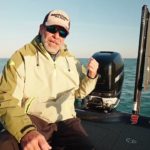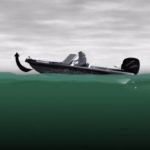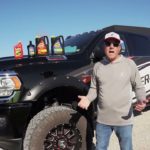Tow Your Boat Safely!
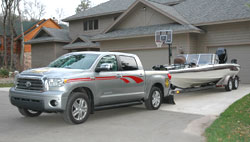 Much is written for anglers on what to do to catch fish when they reach the water. We’ve certainly added our share to that library of information over the years.
Much is written for anglers on what to do to catch fish when they reach the water. We’ve certainly added our share to that library of information over the years.
But little is written on a topic that can literally wreck a fishing trip before it begins.
“Towing Troubles: Danger on America’s Road,” a two-year study released in 2006, noted that towing problems led to more than 400 deaths and nearly 30,000 injuries in 2004, the latest year examined.
The main reason: many motorists lack knowledge or the proper equipment to safely tow boats and other equipment. The trend: accidents related to towing are becoming more common, as more people invest in boats and trailers.
Though the online survey focused on people who tow boats, travel trailers and the like, only one-third felt they were ‘very’ knowledgeable about proper towing practices and safety. The vast majority of those surveyed (71 percent) admitted to being only ‘somewhat’ to ‘not’ knowledgeable. And, incredibly, about one-third said they had no knowledge on the topic at all.
“Too many people are inexperienced with towing, shifting loads and the knowledge you need,” said Dan Williams, truck field manager for Toyota Motor Sales USA, based in Chicago. “You run into safety issues with that.”
The research revealed many people don’t know even the most basic information. For example, more than half did not know or were unsure of their trailer’s gross weight, which is critical to know what kind of vehicle and hitch you need. More than half the people questioned didn’t know or were unsure of the class of hitch already on their vehicle, a rating which determines how much weight can be towed without problems.
Only one in 10 were given towing information from their boat or trailer dealer. In some cases, the fault rested with the drivers themselves. Less than one in four bothered to open the owner’s manual for directions. Three out of four said they learned by trial-and-error, a dangerous classroom at best.
Ignorance, it would seem in many cases, is allowed to rule the day. Nearly two-thirds said they didn’t think they needed more information on safe towing procedures. More specifically, only one in 10 cared to know more about weight distribution. One in 20 wanted to know more about leveling a trailer, a key safety issue, because an improperly-leveled trailer can lead to fishtailing and loss of control.
Williams said Toyota hopes potential customers research what they need before arriving at a dealership. When they don’t, Toyota sales representatives are prepared to walk people through the selection process so they wind up with the vehicle they need. In Toyota’s case, that’s the new, full-sized Tundra.
Apparently, the company is doing it right. Toyota claimed the status of number one in vehicle sales worldwide earlier this year. To meet growing demand for Tundras, a second truck plant was opened recently in San Antonio, Texas. That adds to the plant in Princeton, Ind., where Tundras – the most “American-built in the USA” pickup on the market – have been assembled for several years.
Williams said that, too often, people are only concerned with horsepower, payload and towing capacity. While important, he said people should also consider factors like spring ratings, stopping power and handling.
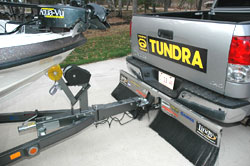 Having enough horsepower and towing capacity are not issues with trucks like the Tundra. Equipped with a V-8, the 2007 Tundra can pull up to 10,000 pounds and handle a payload of 2,000 pounds in the bed. Using a six-speed transmission and gearing designed to provide added muscle, the vehicle has the most torque and horsepower in its class, yet gets 19 miles to a gallon on the highway.
Having enough horsepower and towing capacity are not issues with trucks like the Tundra. Equipped with a V-8, the 2007 Tundra can pull up to 10,000 pounds and handle a payload of 2,000 pounds in the bed. Using a six-speed transmission and gearing designed to provide added muscle, the vehicle has the most torque and horsepower in its class, yet gets 19 miles to a gallon on the highway.
Many pickups have heavy-duty shocks to do the job when loaded. But, take away the boat or travel trailer and they ride “like a rock,” Williams said. “Tundra has special springs to handle that.”
Tongue weight is a measure of what the back bumper or hitch can handle. A good rule of thumb is to have 10 percent of what the total trailer weight is, he said.
“Four-wheel drive is great to have and makes a difference even on dry pavement when pulling a heavy load or a boat out of water on a slippery ramp,” Williams said.
Still, Tundra comes standard with computer-controlled Auto Limited Slip Traction Control so even a two-wheel-drive version gets excellent traction.
And, ask about brakes. “It’s great to brag about towing capacity and horsepower,” says Williams, “but if you can’t stop it, you’re going to have issues.”
The National Highway Traffic Safety Institute offers a checklist of safety issues regarding tow vehicles. Many of the points echo Williams’s take on the subject.
• Before buying a vehicle, check the owner’s manual to be sure the vehicle can tow your trailer and boat.
• Make sure you have the right hitch, especially if you have one installed after-market.
• A towing package should include a heavy duty radiator, battery, flasher system, alternator, suspension, and brakes, as well as an engine-oil cooler, transmission-oil cooler and wiring harness.
• Towing packages rarely include the draw bar, an assembly on which the hitch ball is mounted; the ball mount; or the hitch ball. Make sure you buy the right ones for the job.
• Before leaving home, make certain your vehicle and trailer are well maintained. Tires should be inflated to the proper pressure. Take wheel chocks and jack stands along just in case. The wheel lug nuts should be tightened. Be sure the hitch, coupler, draw bar, and other equipment that connect the trailer and the tow vehicle are correct. Check all lights, including running lights, brake lights, turn signals and hazard lights. Check the brakes. Use all available safety gear, including the break-away switch to stop the trailer in the event it comes loose. Cross safety chains below the hitch to help keep the tongue elevated off the road if it slips free.
• Once underway, use the right driving gear. Feel trailer hubs after a short distance. If hot, bearings need to be greased in a hurry. Drive at moderate speeds to avoid stressing your vehicle or trailer. Trailers are more likely to sway at higher speeds or if the tongue weight is incorrectly balanced. Tandem-axle trailers follow the truck more smoothly and are less apt to sway. Don’t stop or swerve suddenly in either case.
• Here’s a good trick when backing: put your hand (or hands) at the bottom of the steering wheel. When you want to go left, move your hand left. Turn right by moving your hand right. Go slowly. Have someone at the rear to help guide you.
• Avoid parking on grades if you can. Block your wheels.
• Before unhitching, put wheel chocks at the front and rear of the trailer tires.
• One of the features on the new Tundra is a rear backup camera. This nifty device allows you to line up your ball and hitch without assistance from someone else.
Take care when choosing a tow vehicle and towing your boat. It can mean the difference between having a fun day on the water or possibly courting disaster.


